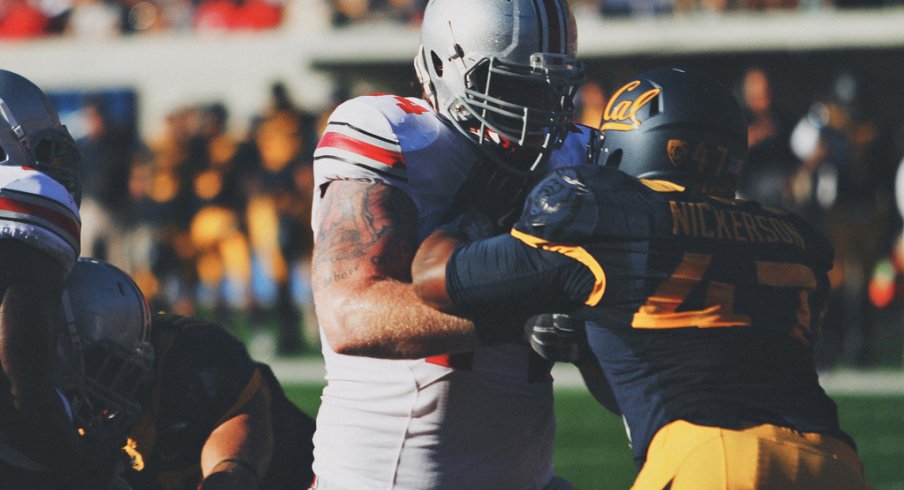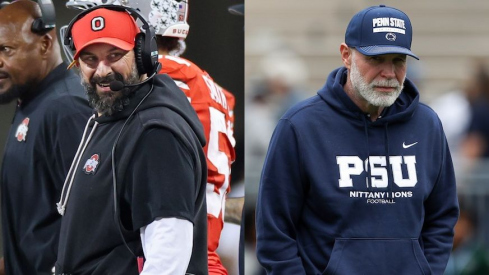Last week we introduced the Tight (Inside Zone) that is the foundation of the Ohio State offense.
After examining how the Buckeyes set up the play, it's time to look at what happens once the ball is snapped.
Covered or Uncovered?
When discussing zone blocking on TV, analysts will often reference a player being "covered" or not on the line, and for good reason. A lineman's responsibilities are determined entirely by this concept, of whether or not there is a defender lined up across from him.
If an opponent is lined up over the real estate directly in front of them, a lineman is considered "covered." That defender must also be on the line, though. Linebackers 4 yards back from the line do not apply here.
As you might have guessed from here, there are multiple ways of being "covered" in these situations, depending entirely on the opponent.
As you can probably imagine, each covered lineman may be in a different situation than their teammate lined up just 2 feet away, meaning his rules are different. To fully illustrate what this looks like in reality, let's look at an example from last year's Michigan game:
Before the snap, we can see each Buckeye lineman's situation:
The situations of four of the five are apparent:
- Left Tackle Jack Mewhort (#74) is Uncovered
- Left Guard Andrew Norwell (#78) is Covered Backside
- Center Corey Linsley (#71) is Uncovered
- Right Guard Marcus Hall is Covered Backside
Although the Defensive End on the right side of the picture is splitting two players, Right Tackle Taylor Decker (#68) is considered to be "Covered Wide Shade" since he is on the play side, leaving Tight End Jeff Heuerman (#86) to be "Uncovered." If the play were designed to go the other way, the roles would be reversed.
Footwork
Given all the thought put into alignment, it should be no surprise that the footwork of each player is critical. As mentioned in part one, there are nearly as many rules and steps for the inside zone as there are offensive line coaches, each with their own tweaks on the basic steps.
There have been two largely traditional first steps for an offensive lineman in the Inside (Tight) Zone:
- Angle: A 45 degree step towards the numbers of the defender with their play side foot, moving vertically as much as laterally
- Lateral: A flat step with their playside foot toward the sideline, keeping their shoulders parallel to the line and only moving laterally
Both schools of thought have countless variations, which we won't get into today, but it appears that the Ohio State offensive line under Urban Meyer prefer lateral first steps.
As we can see in the same play referenced above, the Buckeyes are all staying parallel to the line and not gaining any ground upfield with their first steps.
Due to the alignment of their opponents though, Hall and Decker didn't take the large lateral steps we see from their teammates. Knowing the ball will be coming right behind them, their first steps are known as "Brace" steps.
In this instance, both players took a small first step with their right foots to use as leverage to push off and engage with the opponent. As we can see here, both steps were so quick that they've already started their second step while Mewhort, Norwell, and Linsley are still gaining ground laterally with their first.
Hands
Once OSU linemen have engaged with the opponents, the muscle memory from countless hours of practice takes over. While it may appear that it simply becomes a shoving match at this point, there is a great deal of technique required to win a one-on-one battle with an opposing defensive lineman.
While many readers are firm believers that the lowest man will always have the leverage in such a battle, asking players to keep their knees bent and head low, the reality is that high level offensive linemen are at a huge disadvantage in this department simply due to their size. In the NFL and in major college football, offensive linemen often range from 6'2" to 6'8" in height, and the Buckeyes last year were no different. Many of their opponents on the defensive line are often anywhere from 6'0" to 6'4" though (with exceptions of course), so why should they try to win a contest they're already losing before it even begins?
Instead, the Buckeyes use what's called a "Double Under" technique. The double under technique calls for a double under lifting motion (with palms up, not thumbs out) strike, getting one's hands underneath the pads of the opponent. Some coaches call it a "fish bowl" strike, since the player's hands should look like they're holding the bowl with both hands underneath.
The move was executed perfect by Taylor Decker (who stands 6'8") on this same play against Michigan.
Decker was able to effectively stonewall the defender by keeping his elbows inside and keeping his feet moving in quick, short steps to maintain balance and momentum after a strong first strike, all while he's still technically "higher" than his opponent.
The move is effective for a couple reasons:
- The movement is very similar to that of a power clean, with the blocker's hand starting low and ending high with a straight back. Since these players are big and strong enough to lift hundreds of pounds with this move, they're able to take advantage of existing muscle memory and strength.
- Defensive linemen are trained to swat away the hands of blockers. By keeping their hands low to start, blockers aren't giving defenders an easy target to swat away like a high punch that starts at the chest.
Seeing the importance of quick feet as well as overall strength, it's no surprise to see the Buckeyes focusing their recruiting efforts on big, tall athletes, even if they don't play offensive line at the high school level. Simply having a "mean streak" isn't enough for Meyer's scheme, as on-field coaching and training off the field are both critical factors that lead to success.
Next week we'll conclude the series on the Tight Zone by looking at how the Buckeyes execute combo blocks and block the linebackers at the next level.


